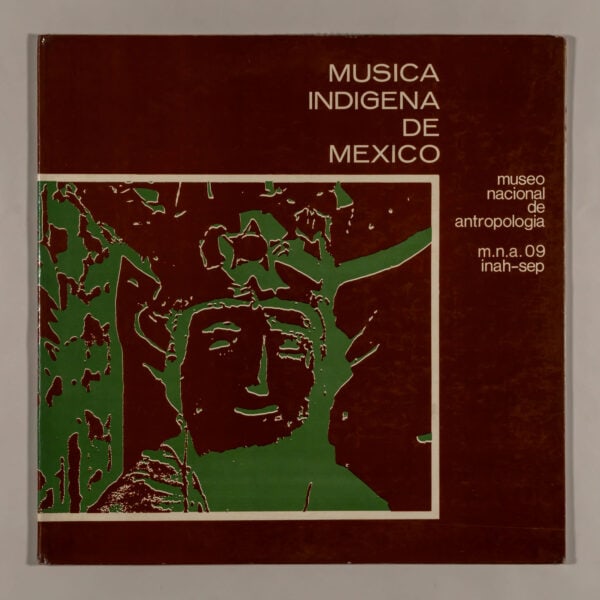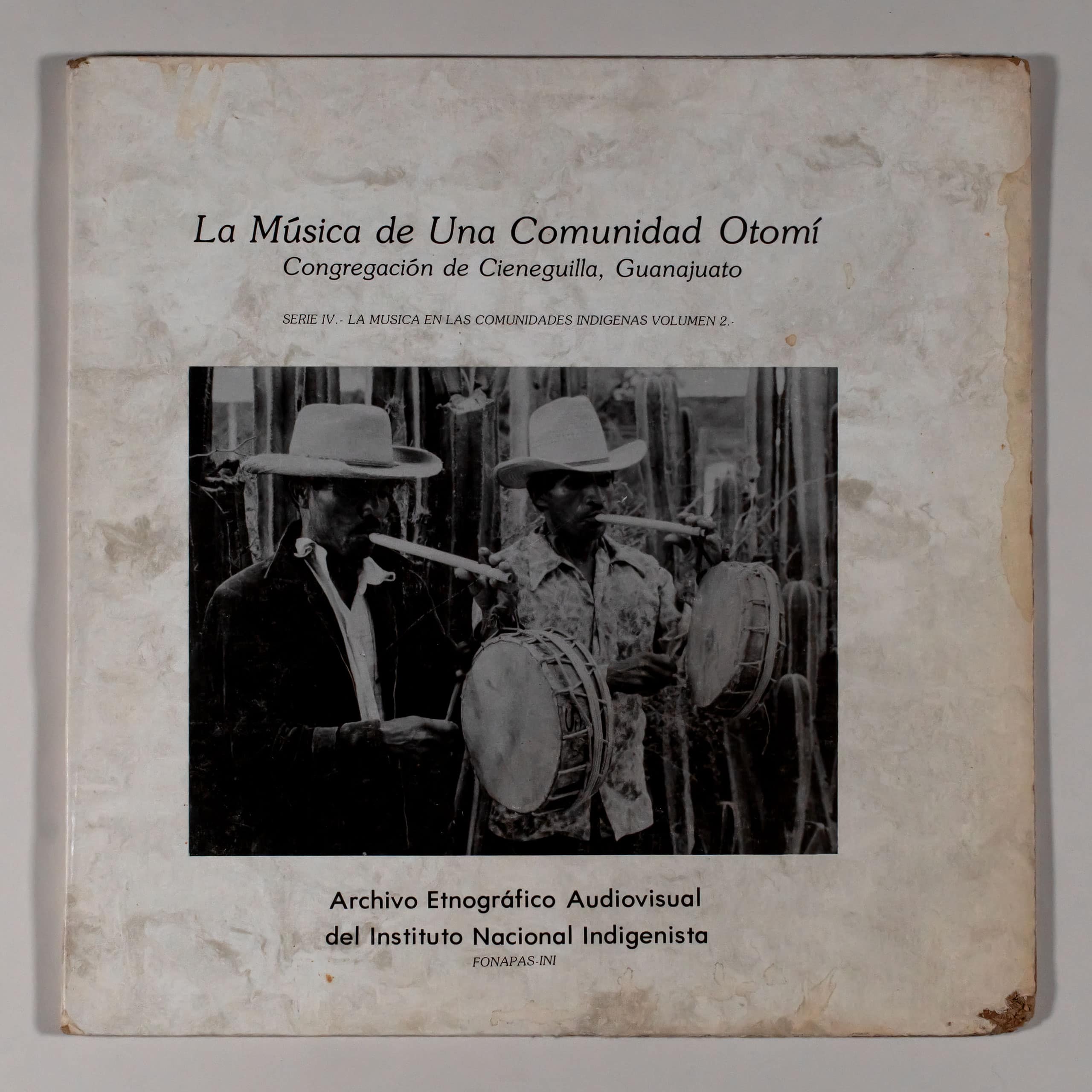MUSIC FROM THE COSTA CHICA FROM GUERRERO AND OAXACA
INAH SEP

|
Label: INAH-SEP INAH-21, MC-0828 Released: 1977 |
Country: Mexico |
Info:
MUSIC FROM THE COSTA CHICA FROM GUERRERO AND OAXACA
INAH 21
NATIONAL INSTITUTE OF ANTHROPOLOGY AND HISTORY
SEP
CHILEAN
The chilena is, perhaps, the distinctive musical genre of the Costa Chica, the coastal region that extends from the south of Acapulco in Guerrero, to the Río Verde in Oaxaca and is practiced by both mestizo and indigenous groups. As its name indicates, it has its origin in Chile and, more precisely, in the Chilean cueca.
In the mid-19th century, the rediscovery of gold deposits in California sparked the so-called “gold rush.” Adventurers in search of fortune moved towards those lands and thus Chilean miners left their homeland in ships that sailed north. The port of Acapulco was an obligatory stopover for those ships, where the sailors would go down with their songs and dances, and probably in this way, the Chilean dance – the dance that best summarized the popular patriotic feeling of independent Chile – was introduced into Mexico.
In Mexican lands, the Chilean developed in a different way from its original model until it became one of the variants of the Mexican son; with which it shares certain musical and choreographic traits: it is a dance for couples and is frequently danced stomping on a platform.
The Chilean dance
Choreographically, this dance recalls the courtship of the rooster to the hen, as suggested by its original name, cueca, which is a derivation of the word broody. The man and the woman carry in their hands a handkerchief that possibly represents the crest or the tail feathers of said birds.
In the region of Ometepec and Cuajinicuilapa, Guerrero, the platform is the trough also called a canoe, because like this it is built from a large trunk and in one piece. The trough or canoe is placed upside down on some sticks that raise it a few centimeters off the ground and the couples dance on it, one at a time.
During the dance, the dancers keep their torso and head immobile while their feet embroider the steps. At one point the couple gets so close that they almost touch lips; suddenly, with an evasive movement, they turn and stand back to back to later come back, dancing, to face each other.
The chilean copla
The most frequent theme of the copla de la chilena is, as in the son, love and the women to whom she sings with naturalness, frankness and humor. Sometimes the lyrics of la chilena describe the natural beauties of the coast or the town native.
The vast majority of the couplets are octosyllabic quatrains with assonance between the second and fourth lines. This form allows any verse to be accommodated to any melody in the repertoire.
It is likely that, in the past, many Chilean melodies lacked their own lyrics and the musician had to improvise them. Sometimes, and to give more animation to the party, two recognized coplers would engage in a challenge to see who had a greater repertoire, and thus, one of them sang a verse that was immediately answered by his opponent. This “contest” ended when one of the coplers exhausted his memory and inventiveness.
A good copler, according to estimates, must know at least around a thousand couplets and also accommodate them to the situations that arise during their singing.
At present the lyrics of the Chilean are sung generally in the first person and it is a masculine song even when performed by a woman. The texts frequently refer to the “brave men” of the “costa brava” (which is also the name of the Costa Chica region), who “know how to kill themselves” according to the lyrics of the Chilean “I’ve already told you”.
Mischief abounds in the texts, a fresh and humorous mischief that nevertheless reflects an atmosphere of a canteen, partying and violence, violence that has been part of daily life in that region for many years now.
The Chilean as a musical form
The chilena, like all the Mexican son, is a form where verses alternate with refrains. The refrain can be a fixed verse or phrase, or a repetition of phrases from the previous or subsequent verse. Exclamations such as “ayrayray” are frequently used in it or “tirananay”. Sometimes the chorus is only interpreted by the instruments.
The chilena has an instrumental introduction that sometimes alternates with the verses and choruses and is often simply the music of a verse performed by a violin or a requintada guitar. This part also serves as a rest for the singers.
When the coplas are sung, the instruments that carry the melody in the intermissions of the chilena remain silent or assume a role of simple accompaniment, as also occurs in most sones. The Chilean is characterized because it ends with one or more farewell verses.
The instruments that accompany the chilena
The violin, a small jarana with five courses (almost always with five strings, although it can have eight or ten), and a harp constituted the traditional set of string instruments to accompany the chilena. Currently the indigenous groups of the area keep the violin and the jarana of the original ensemble. These instruments were made in the Sierra de Coicoyán until about fifteen or twenty years ago and they used to be sold at local fairs, during the winter and spring dry season. Instead the harp is no longer played; however, there are many elderly people in the region who remember its use, as it was very popular at the end of the last century. In addition, since the recording of “La viborita del mar” was made in 1963, it is possible to listen to one of the only two harp players that existed on the Costa Chica in those years.
In addition to the string instruments, a percussion instrument was part of the traditional ensemble. This could be the sounding board of the harp, played by a squatting musician who sounds the lid of the box with one hand and the edge with the other, or it consisted of a wooden box or a large, solid board placed on a hole. on the ground that were played with the palm of the hand and with a stick. Drumming is still found in some Chilean interpretations; For example, on this album it is heard on the recording of a mestizo group: “La viborita del mar” and on that of an indigenous group: “Mariquita mía”.
Frequently, at parties held by indigenous groups –for example, at weddings, when the groomsmen comb the bride’s hair– the chilena is performed only by a violin accompanied by the drumming of a cajón.
The use of drumming in the music and the handkerchief in the dance are probably the only Andean elements that survive in the Mexican chilena and distinguish it from the son.
Currently, to accompany the singing, the original instruments have been replaced, almost everywhere, by the modern sixth guitar and by a requinto tuned to the fifth fret of the guitar. These are not made locally, but come from Mexico City, via Acapulco.
The Chilean danced with an orchestra
Instead, an orchestra consisting of clarinets, saxophones, trombones, double bass, and drums (tambora, military-type drum, and cymbals) is used to dance the chilena. The instruments, especially in small and isolated localities, are property of the municipality; On the other hand, in larger towns or with a better economic condition, they usually belong to individuals. Collectively owned instruments are often old-fashioned, from the mid-19th century, and made in France.
When the Chilean is performed with an orchestra, it is invariably followed by a son. This more energetic rhythm than the Chilean is actually a zapateado and that’s how it is danced from beginning to end; On the other hand, in the Chilean dance, the couples tap their feet only when they are face to face. The piece “María Palitos” followed by the son exemplifies this form. As will be noticed, all the wind instruments follow the melody while the drums mark the beginning of the chilena or the evolutionary changes in the dance.
The son that follows the Chilean is reminiscent of the fugue with which many Andean pieces usually end, since in both cases it is a part performed in a redoubled rhythm that is danced by tapping. This fast section does not occur in the son of other regions of Mexico.
THE CORRIDO AND THE SYRUP
Both genres have in common their relationship with political and military movements, although from different eras. The syrup was the music, song and dance of the independent insurgents, while the corrido accompanied the revolutionaries of the beginning of the century, in different adventures.
THE CORRIDO
The corrido is in full swing on the Costa Chica, and perhaps it is here where its tradition is most alive and where it is most welcome. His current theme no longer has to do with revolutions; now alludes, above all, to gunmen and “braveros”; although, exceptionally, it deals with extraordinary events such as earthquakes, train crashes, and children who are “born speaking”. Its accompaniment is reminiscent of a polka or a waltz, and is played by one or more guitars.
It must also be added that there are “copleros” who maintain it as a specialty. The example that is presented tells the story of a gunman who was famous during the Porfiriato; and due to the theme that this corrido deals with, it is included within what are called “tragedies”, those that are accompanied with a serious and slow musical style.
THE SYRUP
The syrup is found all over the Costa Chica, although it is not touched frequently; A considerable number of regional dances such as La Paloma, El Panadero and Los Monos derive from it. These dances that are performed more often than the syrup are sections of it that have become separate pieces.
FACE A
1. I have already told you. Chilean, Ometepec, Guerrero.
Performers: Juvencio Vargas, sixth guitar and first voice; Moisés Vargas, requinto and second voice.
This piece is interpreted with the typical instruments of the modern Chilean: sixth and requinto guitar; however, it is conservative in terms of text. The music belongs to the repertoire of melodies without fixed lyrics, and the coplas were improvised at the time of recording. After the first farewell, Juvencio Vargas came up with another copla; he sang it, and then finished the farewell. All the couplets are from the traditional repertoire.
2. Chilean Sea Viper. Cruz Grande, Guerrero.
Performers: Eduardo Gallardo, harp and voice; Eduardo Martínez, guitar (jarana) and voice; Rutilo Mejía, drumming and voice.
In this piece other spectators participated in the singing. This Chilean, interpreted by one of the two harper players who were still active on the Costa Chica, also has the partly improvised text; however, the melody is typical of the couplets of La Viborita. As the singer was very old, the other musicians had to help him when he got tired. The drumming on the resonance box of the harp was executed with a ring that Rutilo Mejía had on one finger of his left hand; this is how the dry sound that is perceived in the recording was produced.
3. The Dove and the Oaxacado Syrup. Coastal ranchería in front of Jamiltepec. Wide Stone, Oaxaca.
Performers: Juan Braeamontes, voice; Celerín Domínguez, violin; Torilio Narváez, guitar (five-string jarana).
This syrup –like all of them– consists of several musical sections; and today he is almost unknown on the coast. The main interpreter of it, Juan Bracamontes, a man in his nineties in 1963, when the recording was made, had been a renowned coplero in the San Nicolás region, near Cuajinicuilapa, Guerrero; from there he recently emigrated to Oaxaca. During the recording he was helped by other musicians, as he tired easily.
4. Tragedy of Prisco Sánchez. Corrido. Cuajinicuilapa, Guerrero.
Performer: Ismael Añorvez, sixth guitar and voice.
This is one of the most famous corridos in the region; It tells of the death of a famous gunman at the hands of the army, in the time of Porfirio Díaz. The style of playing the guitar recalls the way of accompanying the corrido repertoire in the past, when it was done with the low quinto, a large guitar with eight or ten strings that were arranged in five courses.
FACE B
1. With care. Chilean. Jamiltepec, Oaxaca.
Performer: Lalo Cisneros, sixth guitar and voice.
This Chilean, and the following, were composed by Álvaro Carrillo during his stay on the Costa Chica, in his youth. For these pieces he used melodies and fragments of traditional couplets from the region. These two are representatives of the modern Chilean, the one that has a more or less fixed letter. Both allude to the man from the Costa Chica who could be characterized as “the bravero” that served as the title and theme of another Chilean due to the teacher Alvaro Carrillo; that is to say, the one who is “a lion among men and fulfilled with women”.
2. The Yerbabuena. Chilean. National Pinotepa, Oaxaca.
Performer: Aníbal Pérez, requinto and voice.
This Chilean was played with a requinto (guitar smaller than the sixth in size); that instrument normally plays the melody in the introduction of the piece and in the intermissions or musical bridges that are made between the couplets. However, since the other accompanying instrument (the sixth guitar) was missing, the musician had to play his own, trying to make it play the role of both.
3. Maria Palitos. Chilean and son. National Pinotepa, Oaxaca.
Performers: “Ecos del Sur” Orchestra of the Cruz brothers.
Listening to this Chilean, all you need is the heat of the coast, beer or soft drinks, and a good turkey in mole, to feel all the euphoric atmosphere of a party in the region. During the performance, a boy of about ten years old, in the son, replaced the musician who played the drums; that change gave that part of the piece a livelier, more lucid rhythm.
The “Ecos del Sur” orchestra, from the largest town on the Costa Chica, is made up of instruments of recent manufacture; It must be added that all performing musicians know how to read music.
4. Chilean from Pinotepa Nacional. National Pinotepa, Oaxaca.
Performers: Aníbal Pérez, requinto and second voice; Humberto Clavel, sixth guitar and first voice.
This Chilean, composed by Álvaro Carrillo, is perhaps the most famous today. The musicians who play it play instruments made by themselves, which are smaller, and in a different way, than those made in the center of the country.
5. My ladybug. Chilean. Jamiltepec, Oaxaca.
Performers: Francisco Mejía, jarana with five strings and voice; Julián Mejía, violin.
This chilena is representative of the indigenous style. The musicians, both of whom are advanced in age, maintain a style that is hardly found anymore; this one is notable, above all, for the turns and rhythm in the voice.
Recording and notes by Tomás Stanford
Secretary of Public Education
Mr. Porfirio Muñoz Ledo
Undersecretary of Culture and Popular Diffusion
Mr. Victor Flores Olea
Director of the National Institute of Anthropology and History
Professor Gaston Garcia Cantu
Museum Director
Professor Iker Larrauri
record series coordinator
Professor Ma, Cristina S, from Bonfil
Disc series director
teacher Irene Vázquez Valle
Mexico, C 1977, 1st edition
Design: S. Perez
Tracklist:
MUSIC FROM THE COSTA CHICA FROM GUERRERO AND OAXACA
SIDE 1
- A1 I already told you –Chilean– Ometepec, Guerrero.
Performers: Juvencio Vargas, sixth guitar and first voice; Moises Vargas, requinto and second voice.
- A2 Little sea viper –Chilean– Cruz Grande, Guerrero
Performers: Eduardo Gallardo, harp and voice; Eduardo Martinez, guitar (jarana) and voice; Rutilo Mejia, drumming and voice.
- A3 The dove and the syrup –?– Coastal rancheria in front of Jamiltepec, Piedra Ancha, Oaxaca.
Performers: Juan Bracamontes, voice; Celerin Dominguez, violin; Torilio Narvaez, guitar (five-string jarana).
- A4 Prisco Sanchez Tragedy –Corrido– Cuajinicuilapa, Guerrero.
Performers: Ismael Añorvez, sixth guitar and voice.
SIDE 2
- B1 With care –Chilean– Jamiltipec, Oaxaca.
Performers: Lalo Cisneros, sixth guitar and voice.
- B2 Peppermint –Chilean– Pinotepa Nacional, Oaxaca.
Performers: Aníbal Perez, requinto and voice.
- B3 Maria Palitos –Chilean and son– Pinotepa Nacional, Oaxaca.
Performers: Orchestra “Ecos del Sur” of the Cruz brothers.
- B4 Chilena from Pinotepa Nacional –Chilena– Pinotepa Nacional, Oaxaca.
Performers: Aníbal Perez, requinto and second voice; Humberto Clavel, sixth guitar and first voice.
- B5 My ladybug –Chilena– Jamiltipec, Oaxaca.
Performers: Francisco Mejia, jarana with five strings and voice; Julian Mejia, violin.
Credits:
Recording and notes by Tomás Stanford.
Design: S. Pérez.
Secretary of Public Education
Mr. Porfirio Muñoz Ledo
Undersecretary of Culture and Popular Diffusion
Mr. Victor Flores Olea
Director of the National Institute of Anthropology and History
Professor Gaston Garcia Cantu
Museum Director
Professor Iker Larrauri
record series coordinator
Professor Ma, Cristina S, from Bonfil
Disc series director
teacher Irene Vázquez Valle
Thomas Standford: Grabador, Escritor de material adjunto
Victor Acevedo Martínez: Editor
Martín Audelo Chícharo: Editor
Guadalupe Loyola Zárate: Editor
Benjamín Muratalla: Editor, Director
Irene Vázquez Valle: Editor
Gabriela González Sánchez: Editor
Mónica Zamora Garduño: Editor
Guillermo Pous Navarro
H. Alejandro Castellanos Garrido: Investigador
Alfredo Huertero Casarrubias: Illustrator
Guillermo Santana Ramírez: Diseñador
Juvencio Vargas: Músico
Moisés Vargas: Músico
Eduardo Gallardo: Músico, Cantante
Eduardo Martínez: Músico, Cantante
Rutilo Mejía: Músico, Cantante
Juan Bracamontes: Músico, Cantante
Celerino Domínguez: Músico
Taurino Narváez: Músico
Ismael Añorve: Músico, Cantante
Lalo Cisneros: Músico, Cantante
Aníbal Pérez: Músico, Cantante
Orquesta Ecos del Sur de los hermanos Cruz: Músico
Humberto Clavel: Músico, Cantante
Francisco Chico Mejía: Músico, Cantante
Julián Mejía: Músico
Juvencio Vargas: Cantante
Moisés Vargas: Cantante
Links:
otroSold For:
Highest Price:
$1000 MXMedium Price:
$1000 MXCondition:
Media Condition:
Mint (M)Sleeve Condition:
Good (G)Condition Notes:
Sealed




















